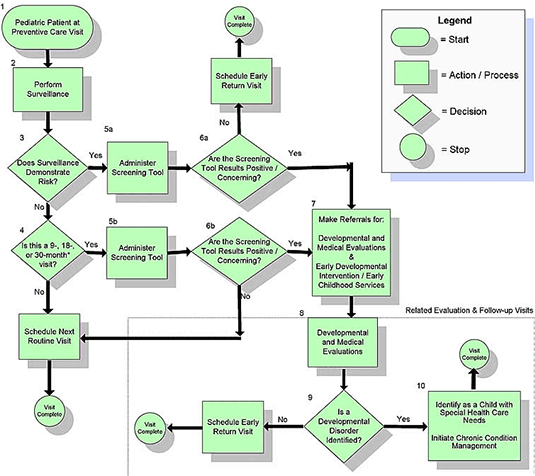Myths in Pediatric Practice
by Caitlin Iglehart and Dr. Patricia Gellasch
Myth #1: All pediatricians conduct developmental screenings
The Department of Health and Human Services reports that as many as 25% of children are at moderate or high risk for developmental, social, or behavioral delays yet as many as 50% of US children are not being screened for delays at their visits. In states like California, the statistic is even more alarming. According to a preliminary report conducted by the Silicon Valley Community Foundation, only 37% of California pediatricians report using an evidence-based screening tool to screen for developmental delays. In contrast, 96% of pediatricians agreed it is important to use a formal tool at recommended intervals.
Why aren’t pediatricians employing evidence-based tools? According to the preliminary report, pediatricians state several barriers: 86% report lack of time, 73% report cost, 64% report lack of referral services, 62% report unfamiliarity with tools, and 55% report lack of training. This brings us to our next myth.
Myth #2: Surveillance and screening are the same!
Clearly, there is a need for greater understanding of the developmental screening process among pediatric providers. One misconception surrounds what qualifies as a screening. Many clinicians consider surveillance and screening synonymous or believe that simply asking informal questions about developmental milestones at a well-child visit qualifies as screening. This misconception leads parents and healthcare providers to believe that children are being appropriately screened for developmental and behavioral delays when they are not. (For more information about the costs of failing to properly screen, visit our blog on The Economics of Developmental Screening.)
Though surveillance and screening are similar in their overarching goal of monitoring developmental health, they are not equal. It is important to understand their differences, limitations, and when each is appropriate. Let’s start by understanding the concept of surveillance.
Surveillance:
The ongoing informal process of surveillance occurs at all clinical encounters. The American Academy of Pediatrics (AAP) describes developmental surveillance as “a flexible, longitudinal, continuous, and cumulative process whereby knowledgeable healthcare professionals identify children who may have developmental problems.” Surveillance is important for identifying when developmental screening tools should be administered outside of the recommended AAP well-child visits.
The AAP lists 5 components of developmental surveillance:
- Eliciting and attending to the parents’ concerns about their child’s development
- Documenting and maintaining a developmental history
- Making accurate observations of the child
- Identifying the risk and protective factors
- Maintaining an accurate record and documenting the process and findings
Screening:
In contrast to the continuous process of surveillance, the AAP describes developmental screening as “the administration of a brief standardized tool aiding the identification of children at risk of a developmental disorder.” Developmental screening tools are designed to identify children who may have developmental issues and serve as a tool to refer children for diagnostic evaluation or early intervention services.
Whenever a problem is identified during developmental surveillance, developmental screening that targets the area of concern is administered. Two to six times more children will be identified when validated developmental/behavioral screening tools are administered compared to when clinicians rely only on their clinical judgment (Hix-Small et. al, 2007, Jee et. al, 2010, Jee et. al, 2010, Schonwald et. al, 2009). According to Glascoe (2000), using only clinical judgment detects fewer than 30% of children who have intellectual and language disabilities or other developmental problems.
The AAP has approved specific screening tools that have been validated to detect developmental delays. These tools include, but are not limited to those listed below. The “General Tools” are validated broadband measures that screen for several types of delays, making them appropriate for developmental screening. The preferred screening measure chosen by the provider must be properly administered which includes completing all questions and scoring according to the authors/publishers instructions. Results must be reported back to the patients’ families in a timely manner. Failure to use validated measures (psychometrically tested) or failing to administer or score a validated tool as it was intended for (i.e., altering questions) will not qualify as developmental screening.
General Developmental Screening Tools:
- Parents’ Evaluation of Developmental Status (PEDS)
- Parents’ Evaluation of Developmental Status- Developmental Milestones (PEDS-DM)
- Ages and Stages Questionnaire (ASQ-3)
- Brigance Screens
- Developmental Assessment of Young Children
Language Screening Tools
Social-Emotional Screening Tools
Autism Screening Tools
- Modified Checklist for Autism in Toddlers (M-CHAT-R/F)
- Childhood Autism Spectrum Test
- Social Communication Questionnaire
So when should we employ surveillance methods and when should we employ screening methods?
Surveillance and screening are both needed to successfully monitor development. The AAP recommends “developmental surveillance at every well-child visit and developmental screening using formal, validated tools at 9, 18, and 30 months or whenever a parent or provider concern is expressed.” In essence, surveillance is an ongoing, longitudinal informal process of monitoring the developmental well-being of a child. In contrast, screening is the formal process of administering a validated instrument (either parent or provider completed) to assess the child’s developmental skills and behavior. Screening should occur at recommended AAP well-child visits, but may also be conducted before or between these encounters, if a concern is raised.
When delays are detected, children should be referred for a diagnostic evaluation or connected directly to intervention services, many of which are free. Intervention services can be found here.
For further reference, here is the AAP’s algorithm for screening and surveillance:

Myth #3: Screening is expensive!
While purchasing screening tests can be expensive, each state reimburses healthcare providers for conducting screenings as do many private health insurers.
Baby Noggin contains validated developmental/behavioral screening tools (Modified Checklist for Autism in Toddlers-Revised and Parents’ Evaluation of Developmental Status: Developmental Milestones) that are AAP approved and widely used by pediatric clinicians. The use of these measures can minimize the cost associated with screening while improving workflow. For more information about developmental screening and to learn about how we are improving the developmental screening process attend our webinar and visit the websites of BabyNoggin, PEDS, and M-CHAT-R.
Watch CEO of BabyNoggin Dr. Jin Lee, Dr. Diana Robins, and Dr. Patricia Gellasch explore the ins and outs of two AAP-approved screening tools, M-CHAT-R and PEDS here.
References
American Association of Pediatrics. (2018). Screening tools. Retrieved from https://www.aap.org/en-us/advocacy-and-policy/aap-health-initiatives/Screening/Pages/Screening-Tools.aspx.
American Association of Pediatrics. (2018). Description and Policy. Retrieved from https://www.aap.org/en-us/about-the-aap/Committees-Councils-Sections/Council-on-Children-with-Disabilities/Pages/Description-and-Policy.aspx.
Glascoe, F. (2000). Early Detection of Developmental and Behavioral Problems. Pediatrics in Review, 22(8).
Hix-Small, H., Marks, K., Squires, J., & Nickel, R. (2007). Impact of implementing developmental screening at 12 and 24 months in a pediatric practice. Pediatrics, 120, 381-389. http://doi.org/10.1542/peds.2006-3583
Jee, S. H., Conn, A., Szilagyi, P. G., Blumkin, A., Baldwin, C. D., & Szilagyi, M. A. (2010). Identification of social-emotional problems among young children in foster care. Journal of Child Psychology and Psychiatry, and Allied Disciplines, 51(12), 1351-1358. http://doi.org/10.1111/j.1469-7610.2010.02315.x
Jee, S. H., Szilagyi, M., Ovenshire, C., Norton, A., Conn, A.-M., Blumkin, A., & Szilagyi, P. G. (2010). Improved detection of developmental delays among young children in foster care. Pediatrics, 125(2), 282-289. http://doi.org/10.1542/peds.2009-0229
Mackrides, P. & Ryherd, S. (2011). Screening for Developmental Delay. American Family Physician. 84(5), 544-549. Schonwald, A., Horan, K., & Huntington, N. (2009). Developmental screening: Is there enough time? Clinical Pediatrics, 48(6), 648-655. http://doi.org/10.1177/0009922809334350
Silicon Valley Foundation. (2017). From the Doctor’s Office: California Pediatrician Survey on Early Childhood Developmental Screening.
The National Academy for State Health Policy. (2016). The Nuts and Bolts of Medicaid Reimbursement for Developmental Screening: Insights from Georgia, Minnesota, and North Carolina. Online.



